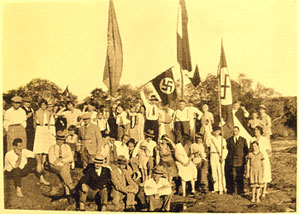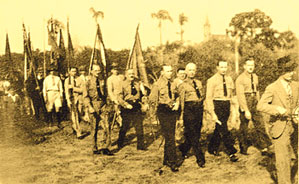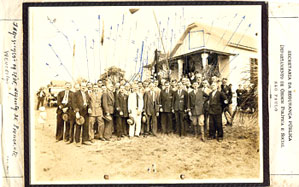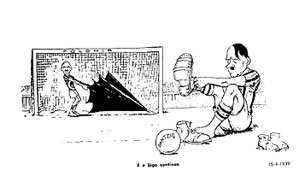
Staatsbibliothek, Berlin, GermanyThe Germans from the towns of Ijuí and Nova Württemberg (State of Rio Grande do Sul) celebrate the Nazi rise to power in 1933Staatsbibliothek, Berlin, Germany
When someone mentions Nazis in Brazil, the first image that comes to mind is that of a ridiculous group of blonds from the State of Rio Grande do Sul raising their right arms in the midst of smoke coming out of a barbecue pit. But the fact is that the Nazi presence was not as picturesque and was of noteworthy political importance, especially with regard to the strengthening of the Estado Novo (New State), the name given to the dictatorial regime of President Getulio Vargas that ruled Brazil seventy years ago. “Tropical Nazism: The Nazi Party in Brazil” is the name of the doctoral thesis of Ana Maria Dietrich, recently presented at the University of São Paulo. It sheds a new light on the old cliché. Ms. Dietrich researched German archives, interviewed former Nazi Party members in the country and even contacted the daughters of Hans Henning von Cossel, the Brazilian Führer who headed the Nazi Party in Brazil. Ana discovered that even Nazism is subject to tropical influences when it flourishes south of the Equator. “This tropical attitude occurred in accordance with the nuances that Brazilian reality imposed upon Nazism. Thus it was possible for Germans and for Brazilians of German descent to celebrate Hitler’s birthday and the typical Brazilian Feast of St. John at the same time, drinking German beer and eating canjica, a typical Brazilian dish made from cornmeal,” says the researcher.
This is the unique aspect of Brazilian style Nazism. However, there are more important – and equally unknown – facts: the Brazilian Nazi Party was active for ten years in Brazil and operated in 17 states (including such unlikely ones as Bahia, Pará and Pernambuco). The Party had 2,900 members, a number only exceeded by the party in Germany. Of the 83 countries with offshoots of Hitler’s NSDAP, Brazil ranks first, ahead of Austria, the Führer’s native country. Indeed, the Brazilian Nazi Party already existed even before Adolph came into power in 1933. A Nazi Party was founded in 1928, five years before Hitler’s ascension to power, by a group from the city of Benedito Timbó, in the State of Santa Catarina. This was not only the first foreign party cell in the country but also the first cell of the Nazi movement outside Germany. Just like the Communists who preached their party’s internationalization, their rivals the Nazis wanted to do the same. “The Nazi Party in Brazil was much more important to Germany than it was to Brazil. The Brazilian Government disregarded the existence of the Nazi Party for ten years, whereas Hitler’s government viewed the Party as the representative of the German people in Brazilian territory, so that any actions taken against the Party had direct consequences on Germany’s relations with Brazil,” says Dietrich. The networking and control of the Party was in the hands of the Auslandorganisation der NSDAP (the Organization of Nazi Parties Abroad, or A.O.), whose head, Ernst von Bohle, was directly subordinated to Rudolf Hess, the number two man in the Nazi hierarchy. Bohle had the same status as party heads such as Joseph Goebbels. The first commandment of the A.O. was the maintenance of the Deutschtum, the “Germanic” characteristics of Germans living outside of Germany, who were not supposed to mingle with the locals nor learn the local language. “In exchange, as a sign of solidarity with the Gastland, i.e., the “host land” of German communities, the community members were not allowed to engage in local politics. The Nazis were supposed to remain neutral in relation to local politics and were not allowed to disclose their ideas to the natives,” the researcher points out.
The propaganda was supposed to appeal to the responsibilities of Germans living outside their native land. “Hitler’s Germany officially rekindled the German people’s feeling of “belonging” to a Germanic nation, whose origins stemmed from the elimination-minded pan-Germanic and Germanic anti-Semitism manifested since the second half of the 19th century,” says historian Maria Luíza Tucci Carneiro, head of the Intolerance Studies Center at the University of São Paulo/USP. Hitler’s election in 1933 counted on the precious votes of those “guests,” including the ones living in Brazil. The swastika, however, did not shelter everyone. One of the tropicalizing factors, says Dietrich, was that the “pure Germans” were considered as being “superior” to the German-Brazilians, as the generation born in the tropics was referred to. This division was the downfall of the Nazi movement: “the creation of a Brazilian-style Fascist movement known as ‘integralismo’ expanded and fascinated the German-Brazilian community in Brazil. Many people joined, because in the thirties, the ideological content of the ‘integralismo’ movement attracted many Germans and people of German descent, especially those who had been ‘discarded’ by international Nazism because of their ‘mixed’ ethnic origins,” the author points out.

Staatsbibliothek, Berlin, GermanyNazi Party group from Hamburger Berg (RS) marching in 1933Staatsbibliothek, Berlin, Germany
However, like all things Nazi, there were some odd events. Within the typical Hollywood-style spirit of Indiana Jones, the Third Reich sent expeditions to Brazil, viewed as a racial laboratory, with the objective of verifying the colonization conditions of the Aryan race in tropical lands. Dietrich points out that in 1936, the Tropical Institute in Hamburg sent a group of German scientists to study German descendants living in the State of Espírito Santo. The group was aided by the Brazilian Government and received support from Henrique da Rocha Lima, who was, according to the researcher, referred to by the Nazis as “our good friend, the professor.” Rocha Lima (who received a medal of honor from the Führer) had taken active part in research studies on yellow fever with scientist Oswaldo Cruz, had been head of the Manguinhos research institute, and had been a serious candidate for the Nobel Prize because of his studies on a variation of typhoid fever transmitted by tics to soldiers in battle trenches. The result of the research study in Espirito Santo stated that “the Aryan race was able to survive in the tropics, provided that any mingling with the local population was avoided.” In line with the spirit of Lebensraum (the search for “vital space” via military expansionism), Brazil had potential, although, in the words of the Führer himself, “we will not land troops to conquer Brazil with weapons in our hands. The weapons we have, for action abroad, are unseen.” The Third Reich was also interested in the Amazon Region. Between 1935 and 1937, another expedition traveled along the Jari River up to the frontier with French Guyana. This expedition resulted in a documentary on the “enigma of the jungle hell”, produced by UFA, the renowned German film studio. An attempt was made “to create a friendly relationship between the Germans and the native Indians,” not to mention the crates filled with animal skins, skeletons, fossils and thousands of archeological artifacts taken back secretly to the Fatherland for further analysis. A cross made from Amazon Rain Forest wood with a swastika engraved on it still exists and marks the grave where Josef Greiner, the Nazi group’s interpreter, is buried.
According to Dietrich, the Brazilian party had a direct link to the Reich and appointed Hans von Cossel run the Brazilin Nazi cell, from São Paulo. He traveled frequently to Germany, where he was introduced to Hitler and praised by Joachim von Ribbentropp, the Third Reich’s foreign minister, as “one of the most fortunate and reliable national heads of the NSDAP, who leads the biggest national group of the A.O.” In 1938, Cossel had the privilege of being the guest of honor at a farewell party organized by Hess, Hitler’s vice-president. Cossel arrived in Rio de Janeiro in 1931 as cultural attaché to the German Embassy. He impressed his superiors so much that he was appointed head of the group in 1934 in lieu of a corrupt colleague, thanks to his ability to maintain open communication channels between Brazilians and Germans and to his relations with Vargas and Hitler. In Germany, Ana Dietrich was able to interview Cossel’s daughters, who told her that Cossel “was highly esteemed by Vargas, who gave him a painting of his in a lovely frame.” They also told the researcher that when Cossel left Brazil in 1942, after the Vargas Regime had broken off diplomatic relations with the Axis, he was invited to work at the German Foreign Ministry. Cossel declined the invitation and entered the Navy instead. “My father said that he looked at them and said: ‘I will not collaborate with this.’ He also told us that he had not been at all impressed by Hitler and had merely sent him reports. The Nazi Party in Brazil was different. As my father had become a member, people thought he knew about everything that was going on, but that wasn’t quite true. Germans are more patriotic when they are abroad, because they have deep feelings for their nation,” Gisela von Cossel said. Family recollections are not always reliable. “Cossel’s relationship with Hitler and Vargas (who, in a letter to the Führer, referred to Cossel as his ‘dear and good friend’) was quite special, which shows the extent of the Nazi movement in Brazil. It was not only a movement embraced by nostalgic colonists, but also something that interfered with the upper echelons of society,” says the researcher, and she is right.
What about the Jewish issue? How did the Brazilian Nazis act in relation to a community which in the thirties had 40 thousand people? Germans and Jews rarely had contact, there are very few records in this respect. Local anti-Semitism was an imported discourse; in other words, it was virtually nonexistent in practice (although it did exist to some extent) and, in theory, it was seen in anti-Semitic publications. But the tone of these articles was the battle between the “Jews over there” and the “Germans over there,” says Dietrich. Tropical racial prejudice was much stronger against Negroes and mestizos, classified as Brazilians in a demeaning way. There are even some hilarious stories on “ethnic” marriages, such as the one between an expatriate from Santa Catarina who decided to “import” an Aryan bride, only to find out that he had married an “ugly woman with one leg shorter than the other.” However, there were other more symptomatic cases, such as the one about Roland Braun, a director of the Nazi Party in São Paulo, who married a Brazilian and named his Brazilian daughter “Irene.” “Also, contrary to general belief, these urban and rural communities were not isolated, and interacted with local society, adopting the local customs and habits.”
The Reich pretended not to “see” these tropical peccadilloes, as the community in Brazil not only provided informal diplomatic services to the Fatherland, but was also a source of funds: “Living in Brazil since 1924, Otto Braun coordinated several foreign exchange transactions, which were forbidden and, when jailed in 1942, provided details on how spying and financial frauds had been conducted in Brazil through Banco Alemão Transatlântico (the “German Transatlantic Bank”), which would transfer money from the community to Swiss banks, which then sent the money on to Germany,” says Dietrich. However, politics was the real tropical side of Nazism, and was ultimately a “gift” to the Vargas Regime: this “gift” was the relationship between the Nazis and the Ação Integralista Brasileira (AIB), a fascist political party founded by Plínio Salgado, whose members wore green shirts and hailed fellow members by shouting “anauê”. “This political party can be viewed as an important characteristic of tropical Nazism because it was an unexpected event that had not been part of the original plan of the Nazi Party’s organization in Brazil,” Dietrich explains. The AIB’s siren song was sweet: “If you were German, you would be a National Socialist. You are Brazilian, so join the Integralista legions and wear the green shirt of those who fight for the good of Brazil.” However, whereas the AIB with its nationalist platform did not agree with German nationalism (although, for propaganda purposes, it would present itself as the feasible way for the tropical Deutschtum to materialize), Nazism did not want the German community in Brazil to become assimilated. “Characterizing it disparagingly as xenophobic, the NSDAP was totally against Germans and their descendants joining the AIB, because the general belief was that this would affect the Germanization of Brazil. In the views of the Third Reich, the AIB was mainly concerned about the racial issue, with the objective of refining the race by reducing the number of Negroes and native Indians and by increasing the number of Europeans. The Nazi Government called this ‘Lusitanianization’ and viewed this as a threat to the Deutschtum.”

São Paulo State ArchivesPhotograph seized by the police at the time when the Nazi Party headquarters were inaugurated in the city of Presidente Wenceslau, in the thirties. The pen marks were made by the secret police.São Paulo State Archives
The researcher adds that the AIB was viewed disparagingly by the Germans in Berlin, and became anathema after their pathetic attempt at a coup against Vargas in 1938, organized with the suspected participation of Brazilian Nazis. In addition to disobeying orders from Germany, the Brazilian putsch also put the German State in an embarrassing position vis-à-vis the Brazilian Government, which the Germans were trying, unsuccessfully, to please, even knowing that Oswaldo Aranha was Getulio Vargas’ foreign relations minister. Oswaldo Aranha preferred to invert the game in favor of the United States, because he felt Americans would be more valuable partners than the Germans, even though in the thirties the foreign trade between Germany and Brazil was twice as great as the trade between Brazil and the Yankees. Plínio Salgado went from being a pebble in the Brazilian dictator’s shoes to one in Hitler’s boots, due to miscalculations in Berlin. “Because people of German descent were forbidden to join the Nazi Party, it lost one of its strongest forces in the South, where the most important German community consisted of German-Brazilians. As a result, people reacted negatively to segregationist Nazism, leaders were not accepted and the AIB party became a feasible option,” the historian analyzes. Taking a dose of its own medicine, traditional Nazism bungled its goose stepping where its tropical version was concerned. The right-wing, nationalistic, conservative movement led by Salgado met the needs of the Brazilian-born Germans, who had been sidelined by the Vaterland (Fatherland).
The end was lots of Kartoffel (potatoes) for the winner. In view of the imbroglio involving the Nazis and the members of the AIB party, Vargas was easily able to chase several organizations into hiding, including the NSDAP branch in Brazil. “Finally, between 1938 and 1942, as part of the project for the nationalization of Brazil that Vargas desired, Germans went from being an ideological hazard due to the dissemination of Nazi ideas, to an ethnic hazard, seen as aliens in relation to the “New Man” that Vargas wanted to build up. When in 1942 Brazil joined the Allies, in World War II, the danger became “military and ideological”, says the researcher. Vargas was in the best of political worlds thanks to the ineptitude of the Nazis and the members of the AIB. He no longer had to worry about individuals worshipping Hitler rather than him. At the same time, the researcher points out, Vargas was able to channel all the authoritarian, xenophobic and nationalistic demands of these groups to his favor. All that was needed was to make them feel as if they were bound to the Estado Novo (New State), rather than to the Third Reich. So here there was, for everyone, a “father of the nation” sort of leader, also anticommunist, in favor of law and order, progress and of the masses.
The same occurred between Mussolini’s Italy and the AIB. “Fascism, initially supportive of Salgado, was very useful to Brazilian right-wingers because it made authoritarian ideas popular and motivated many people to look more kindly upon the Estado Novo”, says historian João Fábio Bertonha, whose doctoral thesis focused on the Italian counterpart of the Ana Dietrich’s thesis. The Fascists, who were more politically savvy than the Germans, played a double game with Vargas and his enemies – the members of the AIB party – for a long time, betting their chips on the future winner. As in the case of the Brazilian Nazis, the children of Italian immigrants chose to support the AIB, unlike their Italian-born parents or grandparents, who were Mussolini Fascists. These Italian immigrants, like the Germans, were also concerned about the ethnic issue, implied in the support of the movement initiated by Salgado; however, after 1938, the Italians ceased to believe in AIB’s revolutionary capacity. The Italian spirit prevailed, much like the German spirit had. However, Salgado was better off with the Italians, because, prior to being forgotten, he had received large sums of money sent from Rome. Strangely enough, the powerful bourgeoisie of São Paulo, fervent supporters of Italian Fascism, closed their coffers to the AIB party. “This left the Italian descendants who, influenced by this national-political context, by the problems they faced in trying to be accepted by Brazilian society, given that they were the children of immigrants, and by the general atmosphere of support for right-wing ideas, driven by Italian propaganda, could have been co-opted by the Fascists. However, due to their cultural adaptation and to their wish to be seen as Brazilian citizens and to be actively engaged in Brazilian politics, many of these people of Italian descent joined the AIB,” Bertonha points out. When the AIB disbanded, they redirected their enthusiasm to the Vargas Regime. So Nazism here turned into feijoada (a typical Brazilian meal consisting of black beans stewed with pork, tongue and sausage and served with rice).
Four variables show how Nazism in Brazil took on tropical hues: tropical racism (i.e., in addition to the Jews, the movement was also prejudiced against Negroes and mestizos, who were in closer contact with the Party); the possibility of mixed marriages and a certain resistance of the local population to taking on German characteristics, exemplified by Roland Braun, the head of the Nazi Party in São Paulo, whose wife was Brazilian and by the fact that many Germans said they “felt at home” in Brazil; the existence of the AIB movement, which had distorted the logic of the model; and the blending of habits, as, contrary to expectations, no German ghettoes had been created, and the Germans interacted with local society, absorbing the local customs and habits,” Dietrich points out. Nonetheless, the propaganda strategies produced some effect on the German immigrants living in the South of Brazil, who, according to Tucci Carneiro, “became indifferent to Brazilian politics and tended to close themselves off,” as documented in a newspaper published by the Nazi community: “We are one million Germans in Brazil. We are an army with no soldiers, a church with no belfry; accept the challenge now. You were summoned to be the leaders of these people, because you are the most intelligent people in this land.” The German community was equally fragmented in relation to the Jews. “Getúlio Vargas surrounded himself with unshakeable admirers of Germany, including politicians and intellectuals, who did not hide their fascination with Germany’s achievements,” says Tucci Carneiro. Part of the German community in the South of Brazil, living in micro regions, believed it was reproducing their Fatherland, now being revived by the Führer.

Folha da Noite newspaper, April 15, 1939 Cartoon by BelmonteFolha da Noite newspaper, April 15, 1939
This close contact of the German immigrants with their native culture resulted in linguistic and cultural isolation, which was battled by political authorities during the Estado Novo, because they interpreted this attitude as “an erosion of the Brazilian spirit.” According to the researcher, this nationalistic discourse was good not only for fighting racial prejudice but also for masking the racist and anti-Semitic values of the political elite, which talked about “promoting the Brazilian man, defending economic development and protecting the country’s social peace.” The professor reminds us that the set of nationalistic and xenophobic decrees passed by the Estado Novo in 1938, as well as the Political Police, legitimized the repressive and preventive actions taken against those who, according to the official discourse, were seen as a threat to the racial background and political order in Brazil. “Who were the people undermining the Brazilian nation? The Jews who had been rendered landless by the Nazi-Fascists. To this ‘scum’ one could add the communists, Negroes and gypsies, all treated as the pariahs of humanity.”
Thus, according to Tucci Carneiro, the neutrality of Vargas regarding the Axis was a mere façade, an appropriate mask for the great statesmen crowned by the glories of Fascism. “This interpretation enables one to understand the tough process of raising awareness about human rights in Brazil. The Contemporary History of Brazil still needs to be written, informing the public about the silence of the Brazilian Government in relation to the Jewish issue. Starting in 1937, Brazil published a number of secret circular letters forbidding the granting of entry visas to Jews and making the entry of “pure Aryans” easier. There are several anonymous letters filed in the archives of the Department of Political and Social Order – Deops, denouncing the landing of Jews in the ports of Rio and Santos. The historian came across a letter written by Oswaldo Aranha, the Foreign Minister of the Vargas régime, who, as chairman of the United Nations, helped create the State of Israel. “In this letter, Aranha states the importance of creating Israel to avoid the immigration of more Jews and to put a stop to the undesired entry of Jews in Brazil,” says Tucci Carneiro. The combination of sauerkraut and feijoada certainly caused historical indigestion worthy of recovery.
Republish